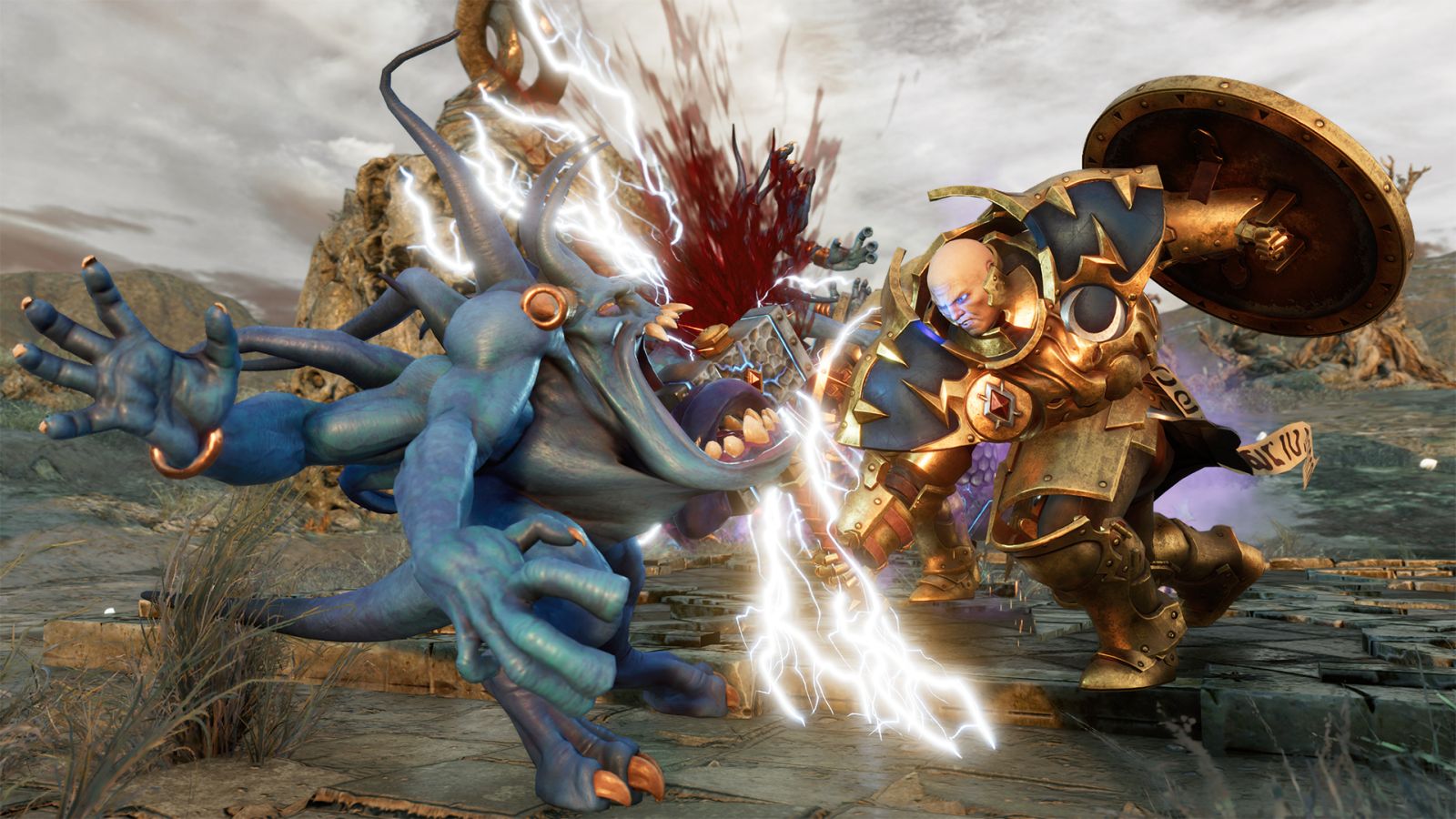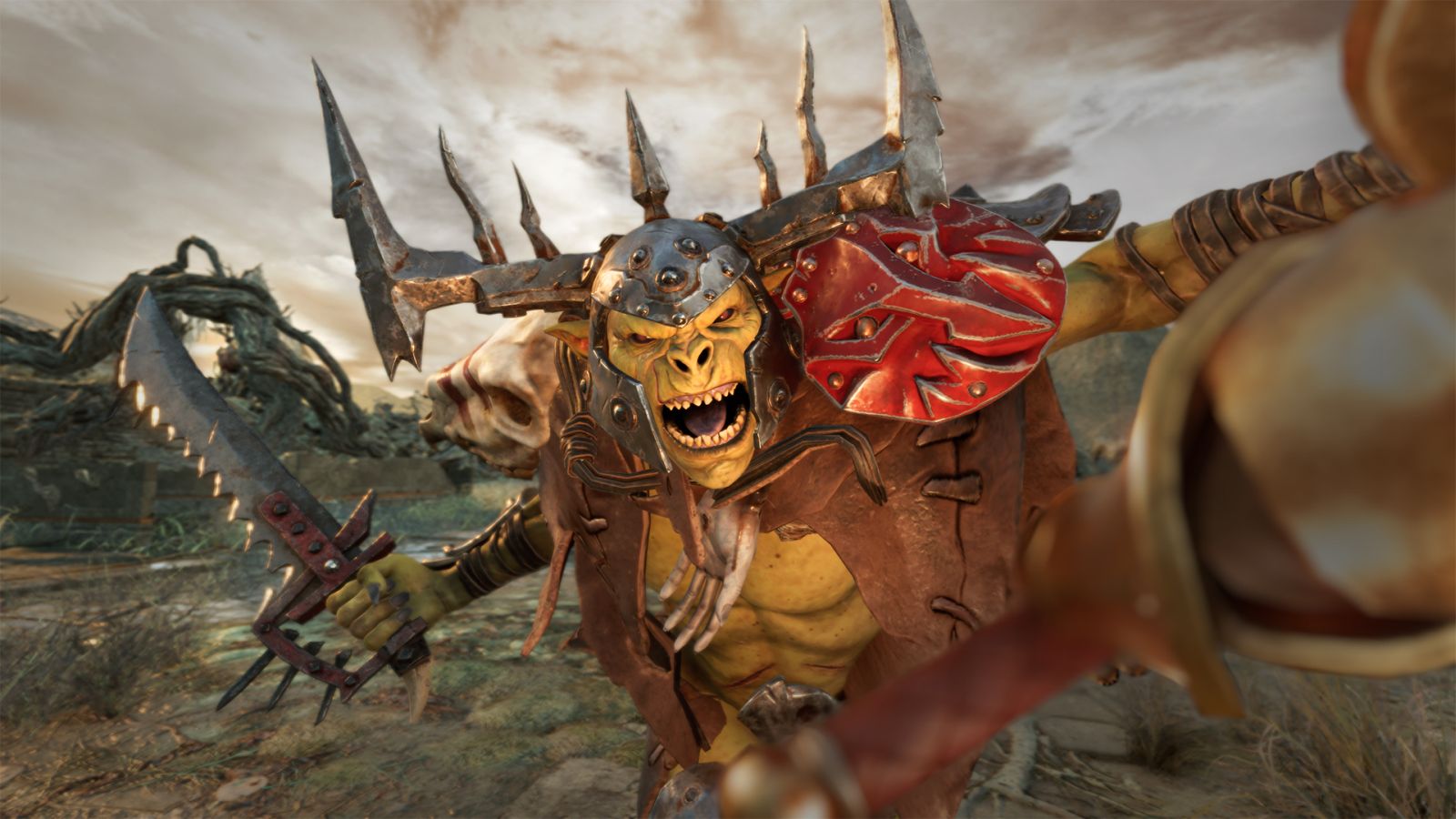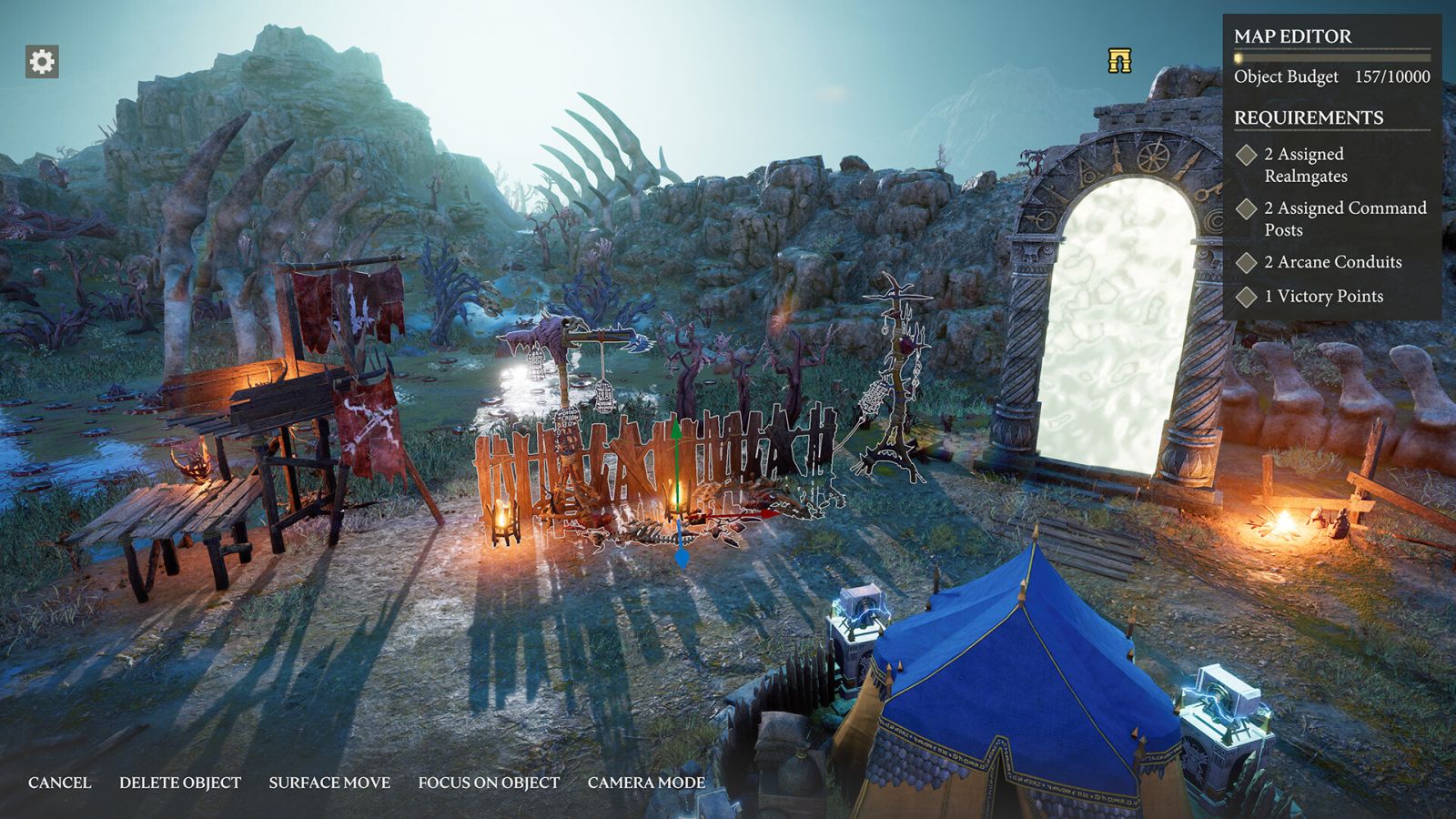One of the reasons I made the jump from to the X86 platform (Yeah, back when they had a “Turbo” button) was for a little RTS called Command & Conquer. I was hooked on real time strategy in a big way, and that hasn’t changed. While the RTS world continues to change and evolve, thanks to games like Homeworld and Company of Heroes, it’s been a bit uneven when applied to the world of Warhammer. After more than a few hands-on opportunities, we’ve gotten our hands on the final version of Warhammer Age of Sigmar: Realms of Ruin. Could this be the next iteration of the RTS genre? Warm up the micro – it’s time to find out.
Up front, let’s classify where Realms of Ruin falls in the broader RTS genre. There are base builders where you dig in, build a force, and then make one big push. Often referred to as “macro” or macromanagement, these are typically focused more on the economic build than the rock, paper, scissors approach with troops. On the opposite side of the coin are micromanagement games, which are all about finding the right troop for the job, and controlling them at a high rate of speed. The specifics inside these genres are what makes or breaks a game, or as they say – “the devil’s in the details”.
Warhammer Age of Sigmar: Realms of Ruin (just Realms of Ruin from now on, if you please) is, as you likely have inferred from the title, taking place in the Warhammer universe. Back in 2015, Games Workshop gave us Age of Sigmar, a tabletop setting that refined the universe into more balanced factions, each with their own pros and cons, as they fight for supremacy. It put it on more even footing with the far-more-developed Warhammer 40,000 universe, luring in new and returning players for more balanced play. If you are coming back to Warhammer and wonder why you can’t find those original tabletop materials, now you know why – Games Workshop killed it dead. While there have been a few nudges into that universe in the videogame world, Realms of Ruin represents our first real battle test of the new setting.
When you need an authentic Warhammer universe created, you turn to folks like Gav Thorpe. Author of the Black Library of Chaos (or simply “Black Library” – an extensive 200+ volume real-world accounting of the Warhammer 40,000 universe), so that’s precisely what Frontier Development has done. What came out of the other side is an incredibly detailed, but highly approachable, introduction for newcomers. It also starts in medias res, so returning players will also know precisely where they are in the lore. A delicate balance, but one that thankfully pays off – this game is story strong, and it helps make up for a few shortcomings on the gameplay side.
Realms of Ruin’s central thrust is a four way battle between four factions – The Stormcast Eternals, Orruk Kruleboyz, Nighthaunt, and the Disciples of Tzeentch. As I mentioned, don’t be dismayed if you don’t know who any of these armies are, you’ll get everything you need to know from the excellent cutscenes and top-tier writing. The game begins with the Stormcast Eternals (the “good guy” faction) touching down in the Realm of Ghur – an untamed wildland complete with dense forests, swamps, and more desolate graveyards than you can shake a warhammer at.
The Stormcast Eternals are heavily modified humans, undergoing “reforging” to become more like the God-King Sigmar, often gaining incredible armor-like skin, incredible strength, and most importantly, immortality of sorts. These heroes serve as the heroes around which the story unfolds. Recognizable names like Sigrun, Iden, and the magician Demechrios are just three of the many you’ll encounter or control directly, and there are many more that I won’t spoil. Beyond these ultra-powerful heroes, Realms of Ruin falls into the aforementioned paper, rock, scissors type of gameplay, but with a few tweaks here and there.

Realms of Ruin’s central loop primarily focuses on a capture and hold gameplay mechanic, and that extends from the campaign to multiplayer. Sword icons indicate assault forces who often have powerful charge attacks. Shields designate your tank units, able to withstand ranged assault and head-to-head skirmishes. A bow indicates that they are ranged, with archers and mages falling into this category. A compass point icon indicates heroes and villains, each with their own strengths and weaknesses. You’ll use this to figure out what units they’ll best counter as you tangle in the field. There are upgrades to help make those troops more efficient, or grant them additional powers, though I’d admit that the upgrades can feel a bit of a mixed bag as too often you won’t feel much of a difference for some of them.
Recruitment happens at your muster points and Command Post. Here you can recruit new troops from your Unit Summoning Menu. In the beginning you’ll naturally have access to basic troops like Vanguard Hunters (good against defenders), but to get more specialized troops you’ll need upgrades. You’ll summon these troops using the game’s two resources – Command Points and Population. You have a cap on your total population, and Command Points are earned from capturing and holding Arcane Conduits – capture and hold points that dot the map. You can, and should, queue units for summoning. Some units take quite a while to bring to the battlefield, and you never know when your fight will go pear shaped and require reinforcements.
Once you do capture an Arcane Conduit, you’ll need to hold it as your foe is trying to hold the same objective. To help, you can build static defenses like a Bastion on that point. It will act as a tower to dissuade the enemy, though it won’t last forever. Upgrades for these defenses cost precious resources you’d otherwise use for troops, so choose wisely. If you are certain you can hold a point as it’s perhaps far enough behind your battle lines to not require defenses you can also choose to place a Defensive Bastion on that Arcane Conduit, but we’ll get back to why that’s not a sound tactic in a bit. These will generate additional Realmstone that can be used on summoning troops, upgrading your other Bastion towers, or even upgrading itself for additional resource production boosts. There are Healing and Vision bastions that operate precisely how you imagine them to.

When your units square off, they’ll be locked into position, effectively fighting to the death unless you tell them otherwise. This is a pull directly from the Age of Sigmar board game which implemented a similar mechanic. If you have some resources to spare, you can also initiate a retreat for that unit, causing them to head back to a muster point to re-forge new troops and bring them back to the fight. The game focuses the game by restricting map size and unit caps, attempting to make the upgrades more meaningful, but also to make these engagements feel weighty. They do, in fact, until you run face-first into a mechanic you’ll encounter in Chapter 2 and every Chapter thereafter.
RTS, regardless of stripe, pits your ability to run an efficient war machine against the AI’s ability to do the same. Since the game doesn’t feature significant base building, you’d imagine that this game does the same, but it does not. Scattered around the map are Realmgates where your enemies will spawn. These are indestructible. Rather than creating a push to slowly conquer the map and feeling nigh-indestructible, it creates a game of whack-a-mole where you suddenly lose an arcane conduit not because you left it undefended, but because the enemy slaughtered your rear guard. Worse, the enemy has unlimited forces that will spawn behind you, retaking your points, so a single peon unit can make you backtrack over and over again. The second chapter is a great example of this, taking me 41 minutes as I essentially re-did the entire thing three times. Later maps have better balance, but some of these are a bit of a slog.
There is a secondary issue that exacerbates the unlimited forces problem – AI bugs. It is frustrating to watch your troops occasionally stand around while their brothers die. Active management of your troops is occasionally necessary lest you have a group standing just a few feet away as your more precious troops get obliterated undefended. Worse, when you are carefully balancing the paper, rock, scissors elements of the game, only to have it come apart the moment you take your eye off it, means you’ll end up on your back heel immediately. While your Vanguard Raptor Hurricanes remind me of the machine gunners from Company of Heroes, they also take a while to relocate and set up their arc of fire, leaving them all but defenseless in the process. When they instead run to the front line, right past your Liberators meant to protect them from harm, it’s hard to feel like you have a good grip on the fight.
Each map contains secondary optional objectives. Completing these provide XP to be spent on optional liveries for your multiplayer banner. Some of these involve liberating captives outside of your normal path, or they can be as simple as completing the chapter inside of a specified timeframe. They won’t change the outcome of the fight, but they often do give you some cool and memorable moments – they are worth stepping off the path to find. And besides – it wouldn’t be Warhammer without liveries and a whole lot of paint!

You can choose from four official palettes for the Orruk Kruleboyz, four for the Nighthaunt, four for the Disciples of Tzeentch, and six for the Knights of Sigmar. Fans of the franchise will immediately recognize the Knights Excelsior, Azyrite Arbiters, Skullbugz, Big Yellers, and Mukdrukkas, just to name a few from the first two factions. Though these are merely cosmetic in nature, it adds a sense of tabletop attention to detail that any fan will appreciate. Know that to use some heroes you’ll need to progress past certain chapters, so don’t think you’ll get out of the campaign that easily. If you are a fan of battling the AI, good news – you can specify them as an opponent in a custom game, allowing you to practice any army you’d like with five difficulties to choose from.
Beyond the single player campaign, there are two more modes – Multiplayer and Conquest. Multiplayer offers up 1v1 ranked, 1v1 casual, and 2v2 online battles. You can also create your own custom game, allowing you to specify one of 15 maps, which of the four factions you’ll use, and far more.
Conquest is an interesting foray into procedurally generated mode with extended longevity and replayability. You’ll set a handful of parameters and then battle your way across a randomized map to increase your glory score. Higher difficulty levels provide bonuses to said Glory, and successfully completing each battle inches your way across the map. You have a finite number of lives (read: attempts at winning a battle) before your light is snuffed out for good. As you battle across the map, additional side objectives can yield additional battle attempts, or additional modifiers such as your foe moving slightly faster, or starting you with additional troops, to carry into future fights. Succeeding against an eventual final battle brings a successful end to this mode with a resultant score at the end.

The final area is simply entitled “Create” and that doesn’t begin to tell half the story. Inside lies the full map editor, a custom army livery system, and a custom army loadout modifier. In here you can create entire maps, modify their weather, paint in hazards like water and rough terrain, add or remove objects, or just about anything else you can think of. If you played Planet Coaster, you might recognize some of the same powerful systems, and that’s encouraging for folks who thrive on creating new content. When you are done, you can publish it to Frontier’s workshop for other players to enjoy. Given that the aforementioned Planet Coaster has over a quarter of a million player-generated maps and objects, you can bet we’ll see plenty of it shortly after launch. Warhammer fans are even more crazy about creating perfect replicas of their lore than coaster fans – especially when it’s this easy thanks to what appears to be the Cobra engine that powered Planet Coaster.
If you are into the lore of Warhammer Age of Sigmar, the Battletome is full to bursting with it. Each of the units in the game, including heroes, have full bios, an ability matrix, – if you forget how something works, the battletome has your answers, an upgrade reference, and a description of potential arcane conduits you might encounter from each faction. Furthermore, a “how to” for every mechanic in the game is in the Battletome, so if you come back to the game after some time, you can get a refresher on the game. Know that there is no warning on spoilers, so tread lightly – you might want to steer clear of this entirely lest you learn more than you intend about what lies ahead.
What struck me most about Realms of Ruin is that the team has worked very hard to take the incredibly complicated and sometimes obtuse aspects of the 3” thick rulebooks, rulers, and lore and brought them to life. Graphically the game is an absolute powerhouse, using a similar technique to Diablo IV by detailing their player models to the point where they look good at 5000 feet, but also look fantastic when zoomed in for cutscenes. The maps are dotted with easter eggs and interesting things that add to the environment. Orruk gear is cobbled together with gear remnants of the foes they’ve faced, and Nighthaunt shimmer with an otherworldly glow. The Disciples of Tzeentch move in an unnaturally lithe way that make them downright creepy. The motion capture (or incredible hand animation – it’s actually hard to tell!) looks fantastic when your troops engage, with a variety of combat animations to mix things up. It’s clear that the team loves the source material, and it shows in every way.

The part that baffles me, but thankfully doesn’t spoil the venture, is the devotion to capture and hold as a mission type. Capture and hold is typically a single option in a game’s arsenal, but here it’s the only option. It feels very MOBA-esque, which is not my favorite genre to mix with RTS, and when combined with the monster-closet approach to enemy spawns, occasionally makes the whole shooting match feel unfair. Upgrading your headquarters allows you to expand your troop count, as well as unlocking additional unit types, but it doesn’t change what you’ll be doing with them – capturing, and holding, and often with a great deal of backtracking.
The reprieves in the capture and hold approach are often more interesting, even being given the ability to try your hand at enemy factions. One mission has you leading the charge of an Orruk task force to burn down three granaries of the Stormcast Eternals. Another has you performing a search and rescue mission without an army. There are even a few tower defense missions. The mission variety doesn’t offer much that we’ve not seen done in other RTS titles, and that lack of ambition hurts the overall formula. Even the Conquest mode which is specifically designed to extend the experience through randomized success criteria and modifiers often settles immediately into the same comfortable approach, albeit with access to all four factions as protagonists. Frankly, without the excellent writing that binds it all together, I’d be worried.
So much of your enjoyment of Warhammer Age of Sigmar: Realms of Ruin is directly dependent on your willingness to see the campaign through. If it resonates with you, you’ll be hooked. If it doesn’t, there’s a very real chance that everything else collapses with it. It is also directly impacted by the fiddly nature of the AI, a handful of bugs, and the endless respawn choice. The complex tug of war for tickets doesn’t thrill me, but for my money, it works best when it takes the handcuffs off and lets me just be an unstoppable force.
Ron Burke is the Editor in Chief for Gaming Trend. Currently living in Fort Worth, Texas, Ron is an old-school gamer who enjoys CRPGs, action/adventure, platformers, music games, and has recently gotten into tabletop gaming.
Ron is also a fourth degree black belt, with a Master's rank in Matsumura Seito Shōrin-ryū, Moo Duk Kwan Tang Soo Do, Universal Tang Soo Do Alliance, and International Tang Soo Do Federation. He also holds ranks in several other styles in his search to be a well-rounded fighter.
Ron has been married to Gaming Trend Editor, Laura Burke, for 28 years. They have three dogs - Pazuzu (Irish Terrier), Atë, and Calliope (both Australian Kelpie/Pit Bull mixes), and an Axolotl named Dagon!

With four playable factions, excellent writing, and a compelling setting, Warhammer Age of Sigmar: Realms of Ruin delivers a solid RTS, albeit one that takes little risk. A handful of bugs and design choices may hamper the fun, but it hits stride when it lets you be powerful and unrestrained.
PROS
- Excellent campaign writing from start to finish
- Some real stand-out and awesome combat moments
- All the great hammy voice work you’ve come to expect
- Gorgeous graphics and animations
- Powerful mission / terrain editor to build your own goodies
- Full Frontier Workshop integration
CONS
- Overly reliant on capture and hold mechanic
- I can’t hate unlimited monster closets enough\
- AI bugs leave your troops to die
See below for our list of partners and affiliates:

























